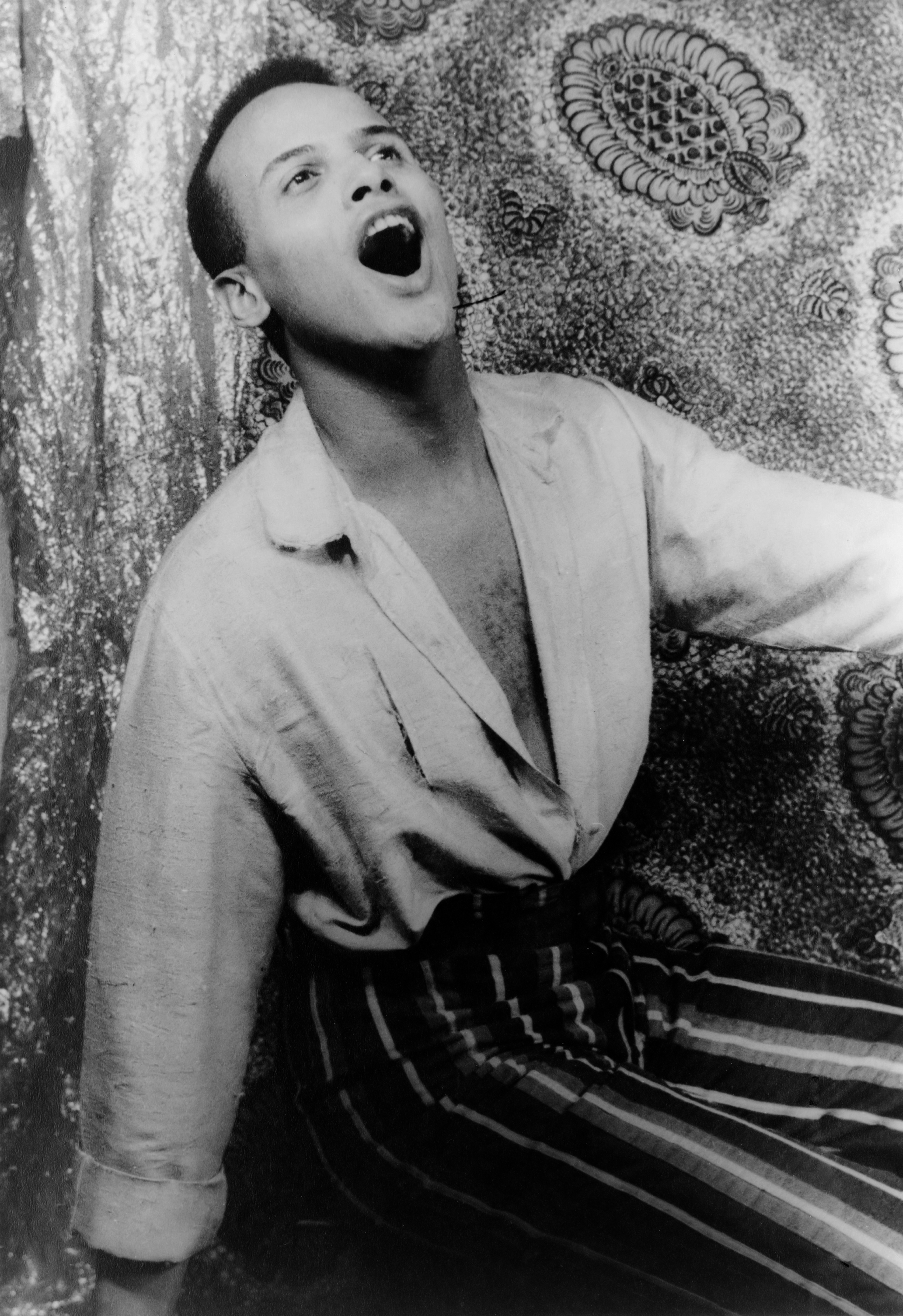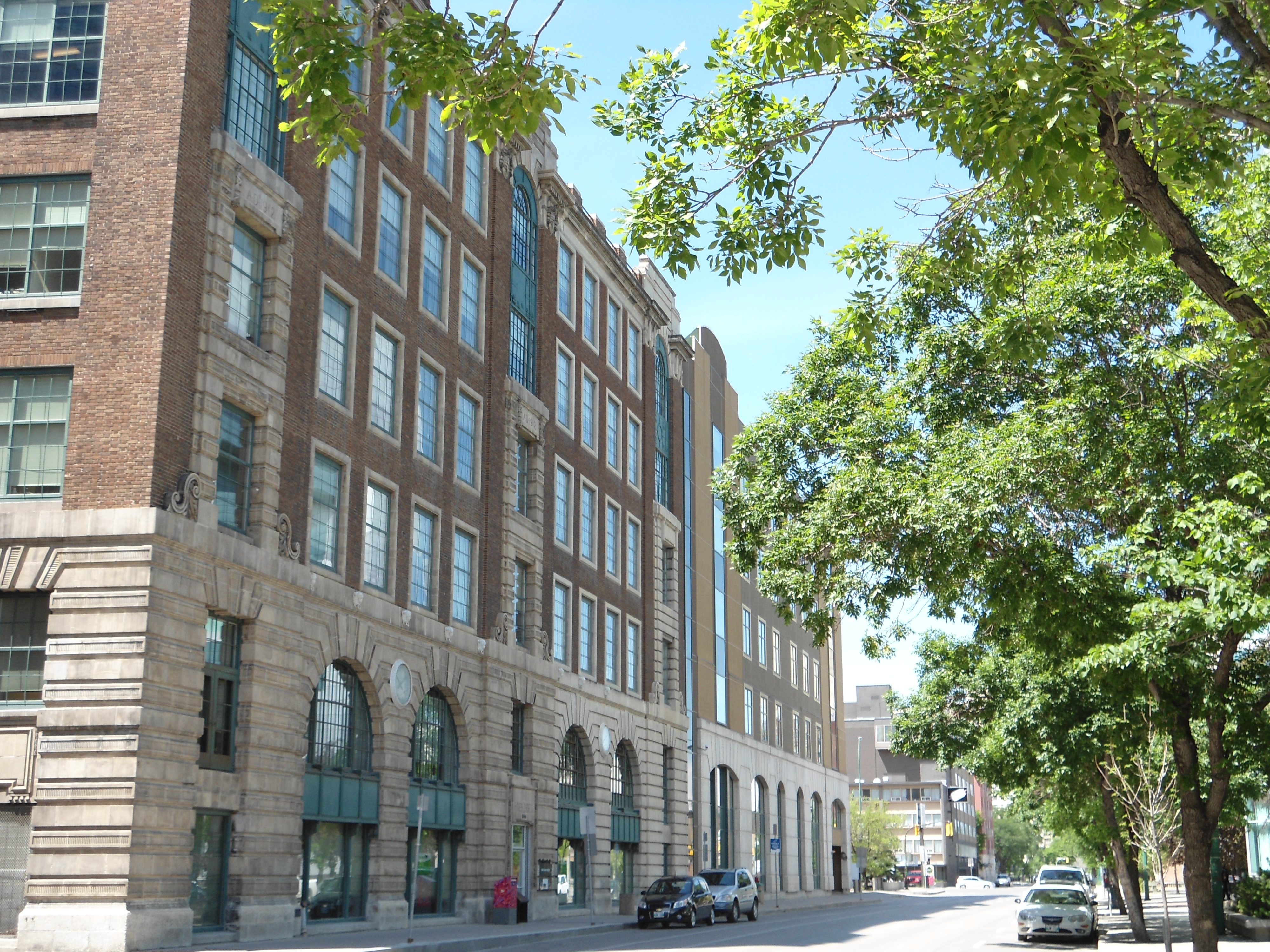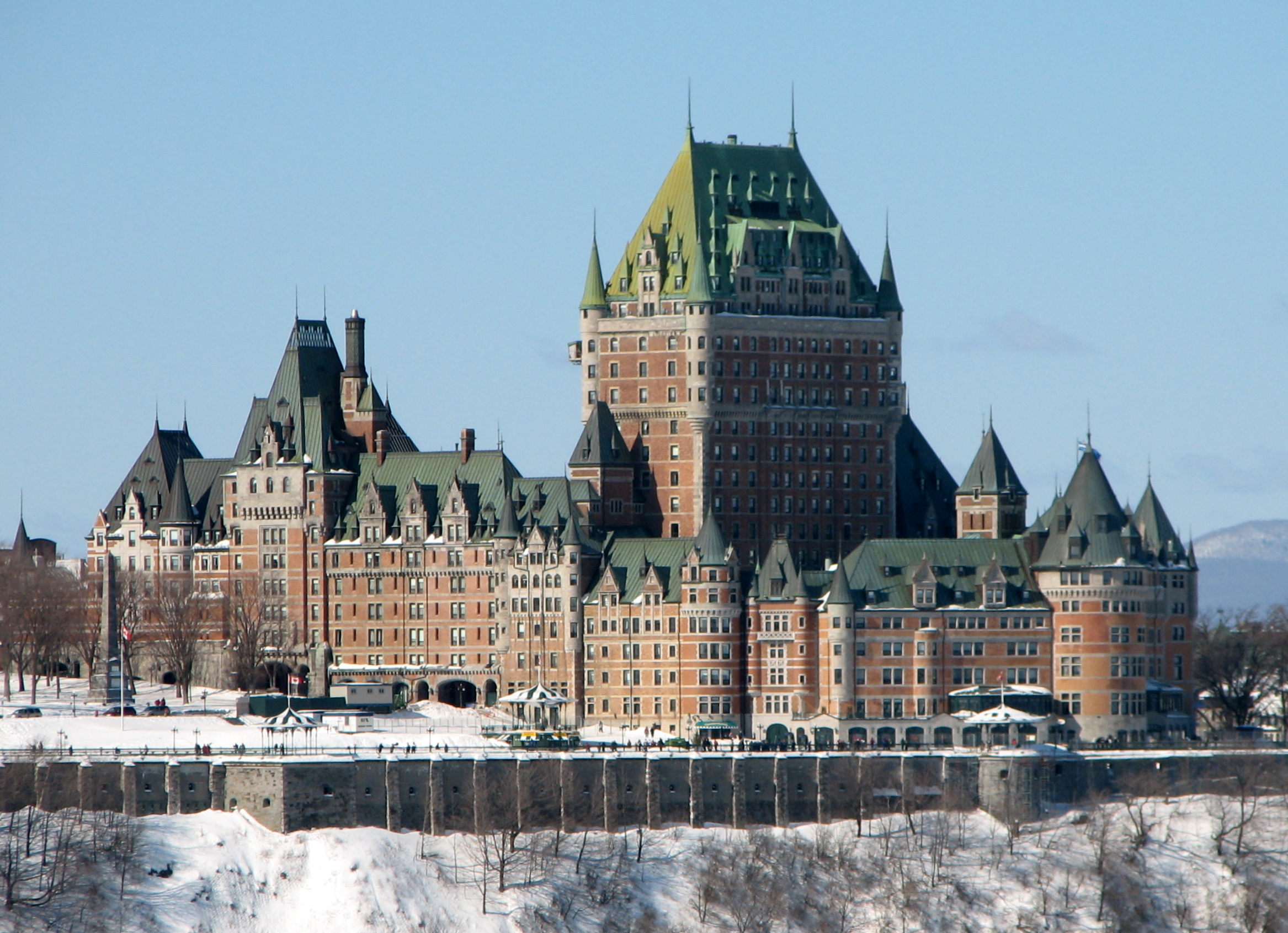|
Fort Garry Hotel (Winnipeg)
The Fort Garry Hotel—officially the Fort Garry Hotel, Spa and Conference Centre—is an early-20th-century hotel in downtown Winnipeg, Manitoba, that opened for the first time on December 11, 1913. Built by the Grand Trunk Pacific Railway, it is one of Canada's grand railway hotels and the only surviving remnant from that era in Winnipeg. It was designated as a National Historic Site of Canada in 1981, and as a Manitoba Provincial Heritage Site in 1990. A national heritage park connected to the hotel and to the remains of Upper Fort Garry was completed in 2017-2018. History The Fort Garry Hotel was built between 1911 and 1913 by the Grand Trunk Pacific Railway in order to service as a luxury accommodation for upper-class railway travellers. Constructed at a strategic location on Broadway, just one block from GTPR's Union Station, the hotel was one of many hotels built by Canadian railway companies in the early 20th century to encourage tourists to travel their transco ... [...More Info...] [...Related Items...] OR: [Wikipedia] [Google] [Baidu] |
Winnipeg
Winnipeg () is the capital and largest city of the province of Manitoba in Canada. It is centred on the confluence of the Red and Assiniboine rivers, near the longitudinal centre of North America. , Winnipeg had a city population of 749,607 and a metropolitan population of 834,678, making it the sixth-largest city, and eighth-largest metropolitan area in Canada. The city is named after the nearby Lake Winnipeg; the name comes from the Western Cree words for "muddy water" - “winipīhk”. The region was a trading centre for Indigenous peoples long before the arrival of Europeans; it is the traditional territory of the Anishinabe (Ojibway), Ininew (Cree), Oji-Cree, Dene, and Dakota, and is the birthplace of the Métis Nation. French traders built the first fort on the site in 1738. A settlement was later founded by the Selkirk settlers of the Red River Colony in 1812, the nucleus of which was incorporated as the City of Winnipeg in 1873. Being far inland, the local cl ... [...More Info...] [...Related Items...] OR: [Wikipedia] [Google] [Baidu] |
Broadway (Winnipeg)
Broadway is a street in the city of Winnipeg, Manitoba, Canada. It is one of the city's oldest and most historic routes and forms the Trans-Canada Highway route through the city's downtown. The street is located between Main Street and Osborne Street, bookended by the Union Station to the east and the Manitoba Legislative Building to the west. Broadway also functions as an unofficial boundary between the commercial and residential areas in the southern part of downtown. Route description Broadway begins at Main Street (Route 52), opposite Union Station, near the confluence of the Red and Assiniboine Rivers. It travels west before merging into westbound Portage Avenue ( Route 85). The street is divided into two distinct sections to the east and west, which are separated by Osborne Street ( Route 62). To the east is the downtown portion of Broadway, which is a picturesque street with a wide, park-like boulevard and elm canopy. The street passes by several of Winnipeg's oldest ... [...More Info...] [...Related Items...] OR: [Wikipedia] [Google] [Baidu] |
Harry Belafonte
Harry Belafonte (born Harold George Bellanfanti Jr.; March 1, 1927) is an American singer, activist, and actor. As arguably the most successful Jamaican-American pop star, he popularized the Trinbagonian Caribbean musical style with an international audience in the 1950s. His breakthrough album '' Calypso'' (1956) was the first million-selling LP by a single artist. Belafonte is best known for his recordings of "The Banana Boat Song", with its signature "Day-O" lyric, " Jump in the Line", and " Jamaica Farewell". He has recorded and performed in many genres, including blues, folk, gospel, show tunes, and American standards. He has also starred in several films, including ''Carmen Jones'' (1954), '' Island in the Sun'' (1957), and ''Odds Against Tomorrow'' (1959). Belafonte considered the actor, singer and activist Paul Robeson a mentor, and was a close confidant of Martin Luther King Jr. in the Civil Rights Movement in the 1950s and 1960s. As he later recalled, "Paul Robes ... [...More Info...] [...Related Items...] OR: [Wikipedia] [Google] [Baidu] |
Nelson Eddy
Nelson Ackerman Eddy (June 29, 1901 – March 6, 1967) was an American actor and baritone singer who appeared in 19 musical films during the 1930s and 1940s, as well as in opera and on the concert stage, radio, television, and in nightclubs. A classically trained baritone, he is best remembered for the eight films in which he costarred with soprano Jeanette MacDonald. He was one of the first "crossover" stars, a superstar appealing both to shrieking bobby soxers and opera purists, and in his heyday, he was the highest paid singer in the world. During his 40-year career, he earned three stars on the Hollywood Walk of Fame (one each for film, recording, and radio), left his footprints in the wet concrete at Grauman's Chinese Theater, earned three gold records, and was invited to sing at the third inauguration of U.S. President Franklin D. Roosevelt in 1941. He also introduced millions of young Americans to classical music and inspired many of them to pursue a musical caree ... [...More Info...] [...Related Items...] OR: [Wikipedia] [Google] [Baidu] |
Manitoba Free Press
The ''Winnipeg Free Press'' (or WFP; founded as the ''Manitoba Free Press'') is a daily (excluding Sunday) broadsheet newspaper in Winnipeg, Manitoba, Canada. It provides coverage of local, provincial, national, and international news, as well as current events in sports, business, and entertainment and various consumer-oriented features, such as homes and automobiles appear on a weekly basis. The WFP was founded in 1872, only two years after Manitoba had joined Confederation (1870), and predated Winnipeg's own incorporation (1873). The ''Winnipeg Free Press'' has since become the oldest newspaper in Western Canada that is still active. Though there is competition, primarily with the print daily tabloid ''Winnipeg Sun'', the WFP has the largest readership of any newspaper in the province and is regarded as the newspaper of record for Winnipeg and the rest of Manitoba. Timeline November 30, 1872: The ''Manitoba Free Press'' was launched by William Fisher Luxton and John A. Ken ... [...More Info...] [...Related Items...] OR: [Wikipedia] [Google] [Baidu] |
Châteauesque
Châteauesque (or Francis I style,Whiffen, Marcus, ''American Architecture Since 1780: A guide to the styles'', The MIT Press, Cambridge, MA, 1969, p. 142. or in Canada, the Château Style) is a Revivalist architectural style based on the French Renaissance architecture of the monumental châteaux of the Loire Valley from the late fifteenth century to the early seventeenth century. The term ''châteauesque'' (literally, "château-like") is credited (by historian Marcus Whiffen) to American architectural historian Bainbridge Bunting, although it can be found in publications that pre-date Bunting's birth. As of 2011, the Getty Research Institute's ''Art & Architecture Thesaurus'' includes both "Château Style" and "Châteauesque", with the former being the preferred term for North America. The style frequently features buildings heavily ornamented by the elaborate towers, spires, and steeply-pitched roofs of sixteenth century châteaux, themselves influenced by late Gothic and ... [...More Info...] [...Related Items...] OR: [Wikipedia] [Google] [Baidu] |
Château
A château (; plural: châteaux) is a manor house or residence of the lord of the manor, or a fine country house of nobility or gentry, with or without fortifications, originally, and still most frequently, in French-speaking regions. Nowadays a ''château'' may be any stately residence built in a French style; the term is additionally often used for a winegrower's estate, especially in the Bordeaux region of France. Definition The word château is a French word that has entered the English language, where its meaning is more specific than it is in French. The French word ''château'' denotes buildings as diverse as a medieval fortress, a Renaissance palace and a fine 19th-century country house. Care should therefore be taken when translating the French word ''château'' into English, noting the nature of the building in question. Most French châteaux are "palaces" or fine "country houses" rather than "castles", and for these, the word "château" is appropriate in English. ... [...More Info...] [...Related Items...] OR: [Wikipedia] [Google] [Baidu] |
Château Laurier
The Fairmont Château Laurier is a hotel with 429 guest rooms in the downtown core of Ottawa, Ontario, Canada, located near the intersection of Rideau Street and Sussex Drive and designed in a French Gothic Revival Châteauesque style to complement the adjacent Parliament buildings. The hotel is above the Colonel By Valley, home of the Ottawa Locks of the Rideau Canal, and overlooks the Ottawa River. The main dining room (now the Laurier Room) overlooks Major's Hill Park. The reception rooms include the Wedgewood-blue Adam Room; the Laurier Room defined by Roman columns; the Empire-style ballroom and the Drawing Room featuring cream and gold plaster ornament. The hotel was designated a national historic site in 1980. History Grand Trunk Railway 1909–1923 Grand Trunk Railway president Charles Melville Hays commissioned Château Laurier, and construction occurred between 1909 and 1912 for , in tandem with Ottawa's downtown Union Station (now the Senate of Canada Building) a ... [...More Info...] [...Related Items...] OR: [Wikipedia] [Google] [Baidu] |
Ottawa
Ottawa (, ; Canadian French: ) is the capital city of Canada. It is located at the confluence of the Ottawa River and the Rideau River in the southern portion of the province of Ontario. Ottawa borders Gatineau, Quebec, and forms the core of the Ottawa–Gatineau census metropolitan area (CMA) and the National Capital Region (NCR). Ottawa had a city population of 1,017,449 and a metropolitan population of 1,488,307, making it the fourth-largest city and fourth-largest metropolitan area in Canada. Ottawa is the political centre of Canada and headquarters to the federal government. The city houses numerous foreign embassies, key buildings, organizations, and institutions of Canada's government, including the Parliament of Canada, the Supreme Court, the residence of Canada's viceroy, and Office of the Prime Minister. Founded in 1826 as Bytown, and incorporated as Ottawa in 1855, its original boundaries were expanded through numerous annexations and were ultimately ... [...More Info...] [...Related Items...] OR: [Wikipedia] [Google] [Baidu] |
Ross And MacFarlane
Ross and Macdonald was one of Canada's most notable architecture firms in the early 20th century. Based in Montreal, Quebec, the firm originally operated as a partnership between George Allen Ross and David MacFarlane (known as Ross and MacFarlane) from 1907 to 1912. MacFarlane withdrew from the firm in 1912, and Robert Henry Macdonald became a partner. The Ross and Macdonald name was used until 1944, after which it became Ross & Ross, Architects, when John Kenneth Ross joined his father as partner. Following George Allen Ross's death in 1946, the firm continued as Ross, Patterson, Townsend & Heughan. By 1970, the firm was known as Ross, Fish, Duschenes & Barrett. Since 2006, it has operated as DFS Inc. Architecture & Design. George Allen Ross Ross (1879–1946) was born in Montreal, and later studied at the High School of Montreal, the Massachusetts Institute of Technology in Cambridge, Massachusetts, and the École des Beaux-Arts in Paris.Antonia Brodie, ed., ''Directory ... [...More Info...] [...Related Items...] OR: [Wikipedia] [Google] [Baidu] |
Assiniboine River
The Assiniboine River (''; french: Rivière Assiniboine'') is a river that runs through the prairies of Western Canada in Saskatchewan and Manitoba. It is a tributary of the Red River of the North, Red River. The Assiniboine is a typical meandering river with a single main channel embanked within a flat, shallow valley in some places and a steep valley in others. Its main tributaries are the Qu'Appelle River, Qu'Appelle, Souris River, Souris and Whitesand River, Saskatchewan, Whitesand Rivers. For early history and exploration see Assiniboine River fur trade. The river takes its name from the Assiniboine people, Assiniboine First Nations in Canada, First Nation. Robert Douglas of the Geographical Board of Canada (1933) made several comments as to its origin: "The name commemorates the Assiniboine natives called by La Vérendrye in 1730 'Assiniboils' and by Governor Knight in 1715 of the Hudson's Bay Company 'stone Indians.' Assiniboine is the name of an Indian tribe and is deri ... [...More Info...] [...Related Items...] OR: [Wikipedia] [Google] [Baidu] |
.png)





